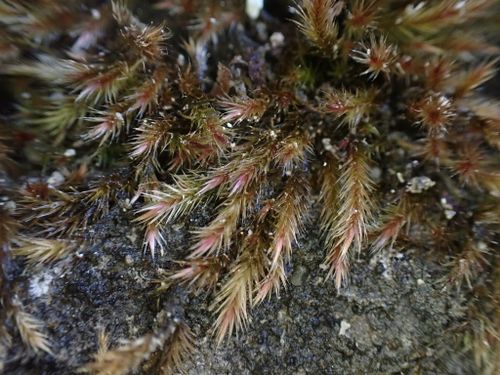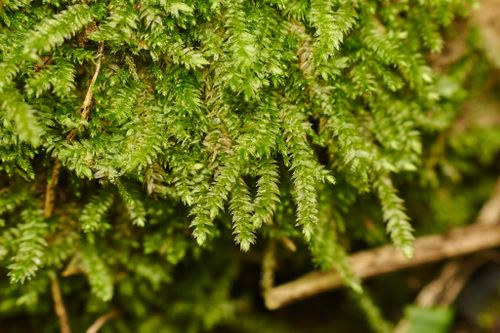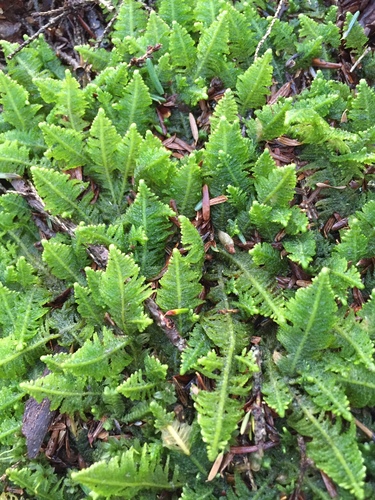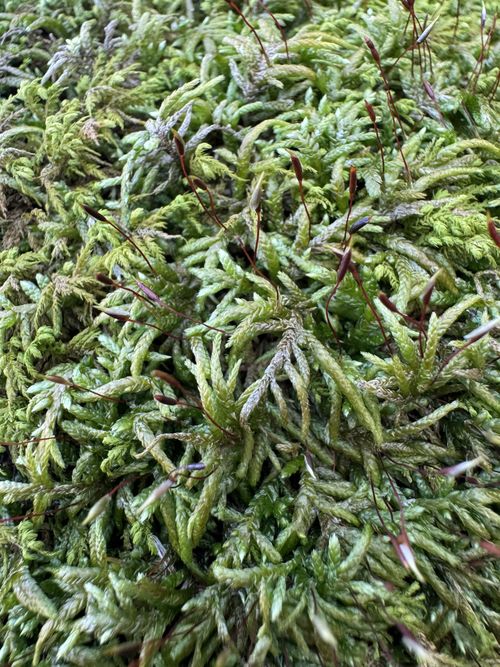Plagiotheciaceae
Silk Moss Family / Plagiothecium Moss Family
Plagiotheciaceae is a cosmopolitan family of typically glossy, pleurocarpous mosses belonging to the order Hypnales. The main genus is Plagiothecium. They are characterized by their often strongly complanate (flattened) shoots, asymmetric leaves lacking a costa (or nearly so), often decurrent leaf bases, and frequent production of asexual propagules.

Overview
The Plagiotheciaceae family, established by Fleischer, is a well-known group of pleurocarpous mosses found worldwide. The large genus Plagiothecium is central to the family, although the inclusion and placement of related genera like Herzogiella and Pseudotaxiphyllum can vary depending on the classification system. These mosses typically form flat, often glossy or silky mats, usually light green to yellowish-green.
A key feature is the strongly flattened appearance (complanate) of the shoots, with leaves arranged in one plane. The leaves are often asymmetric, lack a distinct midrib (costa), and frequently have bases that run down the stem (decurrent), involving differentiated alar cells. Many species in this family readily reproduce asexually via specialized filamentous or cylindrical propagules (gemmae) often found in leaf axils or on stems.
Plagiotheciaceae occupy a wide range of habitats, including soil, humus, decaying wood, tree bases, and rocks, typically in shaded forests, woodlands, or banks, from sea level to alpine zones. Their distribution is cosmopolitan. The family belongs to the large order Hypnales.
Quick Facts
- Scientific Name: Plagiotheciaceae M. Fleisch.
- Common Name: Silk Moss Family, Plagiothecium Moss Family
- Number of Genera: Several, dominated by Plagiothecium.
- Number of Species: Numerous species worldwide.
- Distribution: Cosmopolitan.
- Evolutionary Group: Bryophytes - Mosses (Class Bryatae - Order Hypnales)
Key Characteristics (Moss Features)
Gametophyte (Leafy Plant)
The dominant stage. Plants small to medium-sized, typically glossy or silky, light green to yellowish, pleurocarpous, forming flat mats or loose tufts.
- Stems: Creeping or ascending, usually irregularly branched. Shoots typically strongly complanate (flattened).
- Leaves (Phyllids): Usually complanate, often asymmetric (especially lateral leaves vs. dorsal/ventral leaves). Shape typically ovate-lanceolate to lanceolate, sometimes concave. Apex usually acute to acuminate. Margins mostly plane, entire or serrulate/denticulate towards the apex. Leaf bases often distinctly decurrent (running down the stem).
- Costa (Midrib): Characteristically absent, or very short and double and often faint.
- Leaf Cells: Typically long and narrow (linear or linear-vermicular), smooth, usually thin-walled or moderately thick-walled. Alar cells at the basal corners often differentiated, forming distinct groups of rectangular or somewhat inflated, hyaline cells, typically involved in the decurrent base.
- Asexual Reproduction: Frequent in many species via specialized, multicellular propagules (gemmae), which are often filamentous or cylindrical and borne on stems, leaves, or in leaf axils.
Reproductive Structures (Gametophyte)
Antheridia and archegonia are borne in lateral buds on the stems.
Sporophyte (Spore-Producing Structure)
Arises laterally from the gametophyte stem. Consists of:
- Seta: Usually long, slender, smooth, often reddish or yellowish.
- Capsule (Sporangium): Typically inclined to horizontal, ovoid to cylindrical, often asymmetric and curved, frequently constricted below the mouth when dry and empty (strumose). Operculum usually conical or rostrate.
Peristome
Typically double and well-developed (hypnoid type). Consists of 16 outer exostome teeth (often cross-striolate below) and an inner endostome with a high basal membrane, well-developed segments, and often cilia.
Field Identification
Identifying Plagiotheciaceae involves recognizing their flattened, often glossy appearance and specific leaf details:
Primary Identification Features
- Strongly Complanate Shoots: Plants typically form distinctly flattened mats or patches.
- Glossy/Silky Appearance: Often shiny, light green to yellowish-green.
- Costa Absent / Very Short Double: Lack of a distinct midrib is crucial (use hand lens).
- Asymmetric Leaves: Lateral leaves are often shaped differently from dorsal/ventral leaves.
- Decurrent Leaf Bases: Leaf bases often run down the stem (visible with hand lens).
- Asexual Propagules: Look for small filamentous or cylindrical gemmae on stems or in leaf axils (common in many species).
- Habitat Versatility: Found on soil, humus, wood, rocks in shaded environments worldwide.
Common Confusion Points
- Entodontaceae: Also glossy, complanate, and ecostate. Distinguished by usually being more robust, often golden/brownish, having non-decurrent leaves with different alar cells, and characteristically erect, symmetric capsules.
- Hypnaceae: A large family; some species may be complanate or ecostate but usually differ in glossiness, cell structure, leaf symmetry, or capsule orientation.
- Mniaceae / Plagiomniaceae: Can have large, complanate leafy shoots but are typically acrocarpous (or appear so), possess a strong single costa, and have different cell shapes.
- Stereophyllaceae: Very similar, sometimes included within Plagiotheciaceae. Distinction often requires microscopic details.
Field Guide Quick Reference
Look For:
- Glossy/silky, flat moss mats
- Strongly complanate shoots
- Leaves often asymmetric
- Costa absent or very short/double
- Leaf bases often decurrent
- Asexual propagules often present
- Cosmopolitan, various habitats
Key Variations:
- Degree of glossiness and complanation
- Leaf shape (e.g., symmetric vs. asymmetric, presence of undulations)
- Presence/type of propagules
- Capsule shape/orientation
- (Many species within the family)
Notable Examples
The family is large, with Plagiothecium being the most prominent genus:

Plagiothecium denticulatum
Dented Silk Moss
A very common and widespread species found across the Northern Hemisphere and elsewhere. Forms glossy green, flat mats on soil, wood, and rocks in forests. Known for its asymmetric, decurrent leaves and frequent production of asexual propagules.

Plagiothecium laetum
Bright Silk Moss
Another common species, often confused with P. denticulatum. It typically forms brighter green, silkier mats and may differ in subtle leaf shape and propagule details. Widespread distribution.

Plagiothecium undulatum
Waved Silk Moss
A distinctive, larger species, often whitish-green and less glossy, recognized by its strongly transversely undulate (wavy) leaves. Typically found on acidic humus in coniferous forests, particularly in oceanic regions.
Phylogeny and Classification
Plagiotheciaceae is classified within the Class Bryatae (true mosses) and is a well-recognized family within the large pleurocarpous order Hypnales. Molecular phylogenetic studies confirm its placement within this order, often showing relationships with families like Stereophyllaceae, Hypnaceae, and Entodontaceae.
The family represents a major lineage of complanate pleurocarpous mosses characterized by ecostate leaves, specific alar cell structures (often decurrent), and frequent asexual reproduction. The exact circumscription of the family (which genera to include besides Plagiothecium) can vary, reflecting ongoing research into the complex relationships within the Hypnales.
Position in Plant Phylogeny
- Kingdom: Plantae
- Division: Bryophyta (Mosses)
- Class: Bryatae (or Bryopsida)
- Order: Hypnales
- Family: Plagiotheciaceae
Evolutionary Significance
Plagiotheciaceae represents a globally successful lineage of pleurocarpous mosses, demonstrating significant adaptation to a wide range of shaded terrestrial and epiphytic habitats. The prevalence of asexual reproduction via specialized propagules in many species highlights an effective strategy for colonization and local persistence. The family's characteristic complanate growth form and ecostate leaves showcase morphological variations within the Hypnales, providing valuable subjects for studying bryophyte adaptation and evolution.



